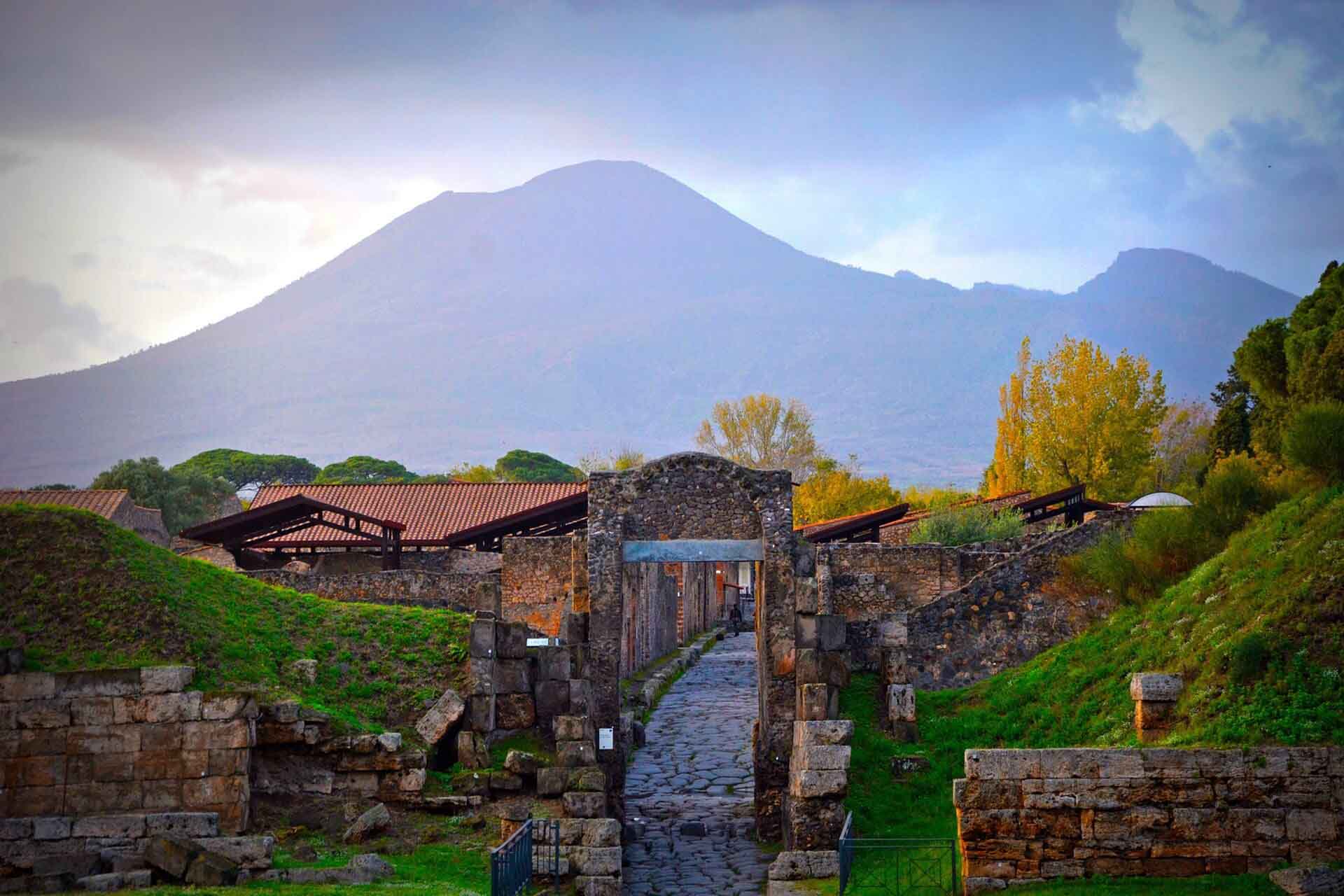

Unveiling Pompeii: A Comprehensive Guide to the Ancient City Frozen in Time
Nestled near the scenic Bay of Naples in southern Italy lies one of the most remarkable archaeological sites in the world: Pompeii. Once a bustling Roman city, Pompeii met its tragic fate when it was engulfed by the catastrophic eruption of Mount Vesuvius in 79 AD. Frozen in time under layers of volcanic ash and pumice, Pompeii remained remarkably well-preserved for centuries, offering modern-day visitors a rare glimpse into ancient Roman life.
 Introduction to Pompeii
Introduction to Pompeii
A testament to the unpredictability of nature and the fragility of human existence
Welcome to Pompeii, a captivating ancient city frozen in time by the catastrophic eruption of Mount Vesuvius in 79 AD. Nestled near the Bay of Naples in southern Italy, Pompeii offers a unique glimpse into the daily life, culture, and tragedy of the Roman Empire. With its well-preserved ruins and archaeological wonders, Pompeii stands as a testament to the enduring power of history and the resilience of the human spirit.

Roaming Pompeii: Uncovering Its Endless Marvels
Exploring Pompeii is akin to stepping into a time machine, offering an unparalleled opportunity to witness the daily life of ancient Romans frozen in time. As you wander through the remarkably preserved streets, you'll encounter ancient buildings, temples, and houses that once bustled with activity. From the grandeur of the Forum, the city's political and social hub, to the intimate interiors of residential villas adorned with vibrant frescoes, every corner of Pompeii tells a story of the people who once called this city home.
One of the most intriguing aspects of exploring Pompeii is the chance to see firsthand the remnants of daily life that have survived for nearly two millennia. Marvel at the intricate mosaic floors that adorned luxurious villas, depicting scenes of mythological gods and everyday activities. Admire the ancient graffiti etched into the walls, offering glimpses into the thoughts and concerns of Pompeii's inhabitants. Each step reveals new discoveries, inviting visitors to immerse themselves in the sights, sounds, and sensations of ancient Rome.
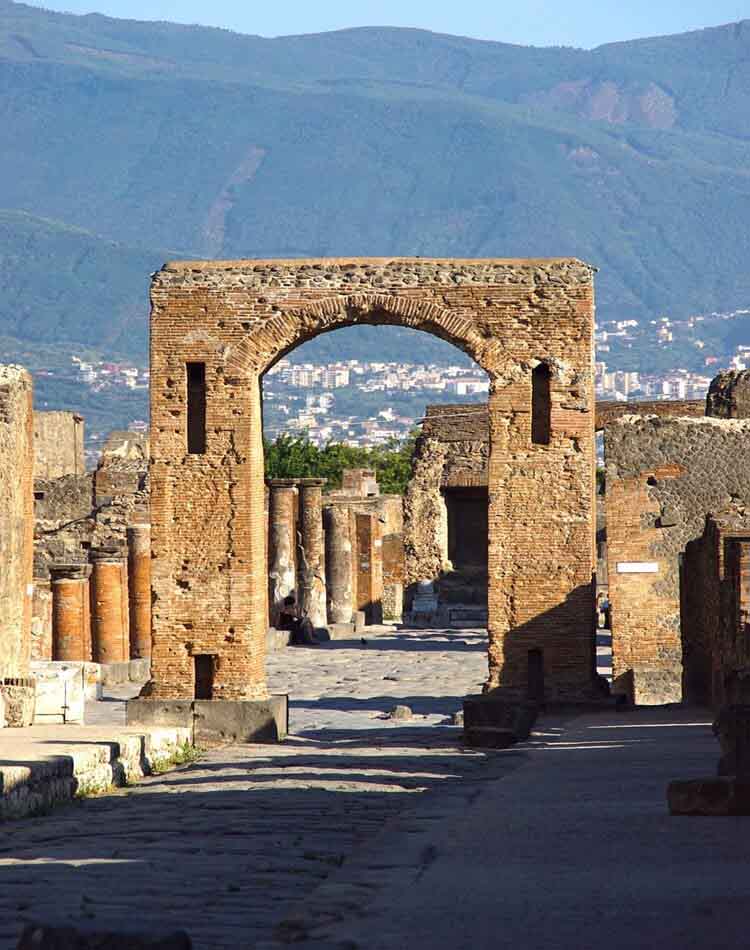
Beyond the architectural marvels and artistic treasures, exploring Pompeii also provides insights into the daily rituals and customs of its inhabitants. Visit the public baths, where Romans once gathered to socialize, relax, and cleanse themselves in communal pools. Explore the thermopolia, ancient fast-food establishments where residents dined on street food and wine. Wander through the macellum, or food market, where vendors sold fresh produce and seafood to eager shoppers. With each discovery, you'll gain a deeper understanding of the vibrant tapestry of life that thrived within Pompeii's walls.
What to Expect in PompeiiPompeii Attractions
When visiting Pompeii, expect to embark on a journey through time, delving into the rich history and tragic fate of this ancient city. Here's what you can expect to see and experience:
- Well-Preserved Ruins:
Pompeii boasts remarkably well-preserved ruins, including temples, theaters, public baths, and residential buildings. You'll have the opportunity to explore these structures up close, marveling at their intricate architecture and craftsmanship.
- The Forum:
As the heart of ancient Pompeii, the Forum was the center of political, social, and economic life. Expect to see the remains of important civic buildings, temples dedicated to Roman gods, and the bustling marketplace where residents once traded goods.
- Vibrant Frescoes and Mosaics:
Pompeii is renowned for its colorful frescoes and intricate mosaic floors. Expect to encounter these ancient artworks adorning the walls and floors of villas, providing insights into Roman aesthetics and daily life.
- Cast of Characters:
Pompeii's ruins are not just architectural; they're also a window into the lives of its former inhabitants. Expect to see plaster casts of the victims preserved in their final moments, offering a poignant reminder of the city's tragic demise.
- Streets Frozen in Time:
Wander through Pompeii's ancient streets, which remain remarkably intact. Expect to see the stone-paved roads, chariot ruts, and stepping stones used to navigate flooded thoroughfares, providing a glimpse into daily life in antiquity.
- Public Amenities:
Explore the city's public amenities, including thermal baths, theaters, and amphitheaters. Expect to see the grandeur of these structures and imagine the events and activities that once took place within their walls.
- Mount Vesuvius:
From various vantage points within Pompeii, expect to catch breathtaking views of Mount Vesuvius, the volcano responsible for the city's destruction. Its imposing presence serves as a constant reminder of Pompeii's tragic past.
- Archaeological Excavations:
Pompeii is an ongoing archaeological site, with ongoing excavations uncovering new discoveries. Expect to witness archaeologists at work and possibly see new artifacts being unearthed, adding to the ever-evolving story of the ancient city.
Explore More
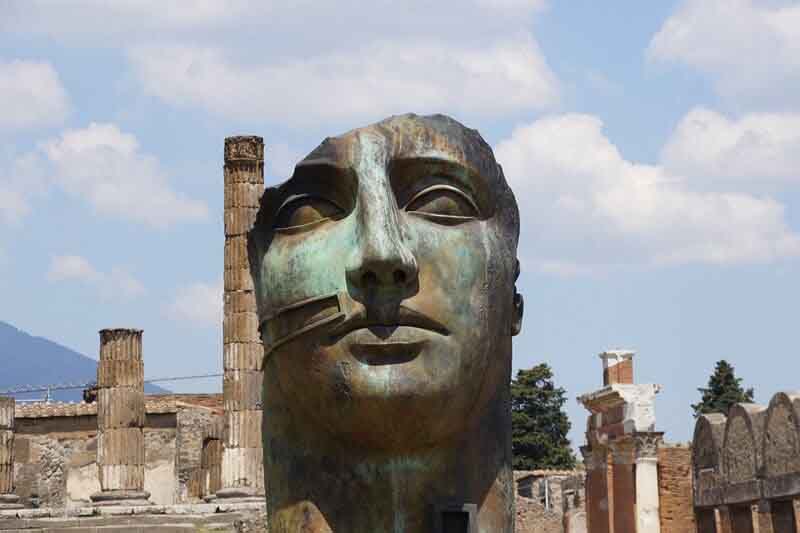
Exploring Ancient Artistry
Step into the past as you gaze upon the face sculpture found in Pompeii. This remarkable piece of ancient artistry offers a glimpse into the craftsmanship of the time, capturing the intricate details and expressions of its subject. Immerse yourself in the history and culture of Pompeii as you marvel at this captivating sculpture.

Exploring the Timeless Remnants of Pompeii
Wander through the ancient ruins of Pompeii and marvel at the enduring legacy of this once-thriving city. Each stone and structure tells a story of life in ancient Rome, offering a glimpse into the past that has fascinated visitors for centuries.
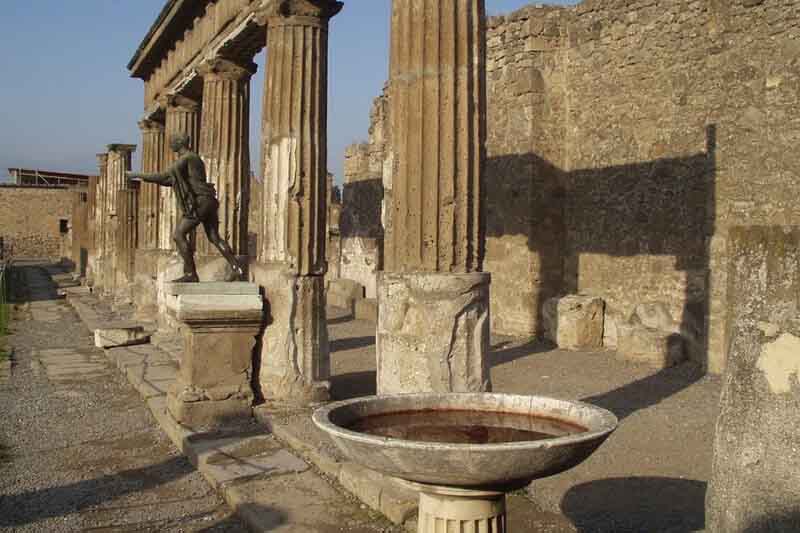
Discovering the Grandeur of Pompeii's Architectural Marvels
Behold the majestic columns and serene pool of Pompeii, testaments to the architectural prowess of ancient Rome. Explore the harmonious balance of form and function as you admire the intricately carved columns and the tranquil waters that once graced this ancient city. Let the timeless beauty of Pompeii's architectural wonders transport you to a bygone era of splendor and grandeur.
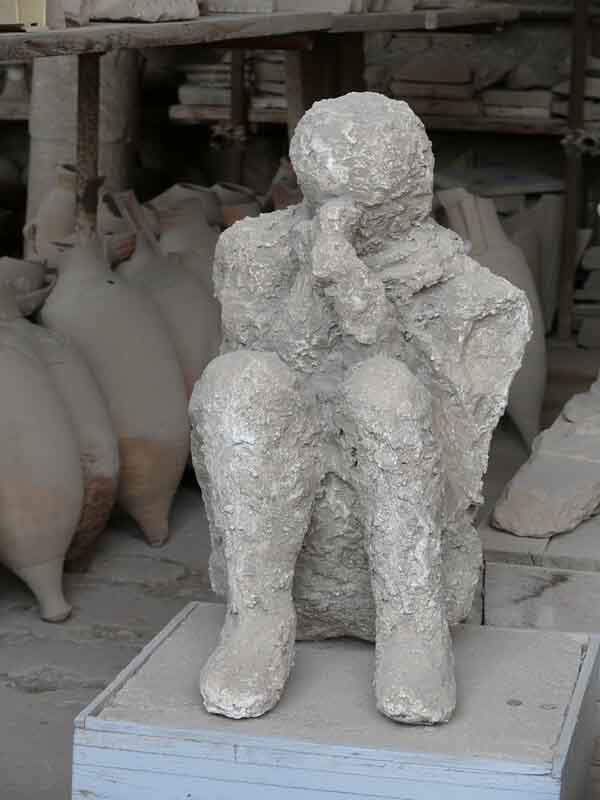
Witnessing the Tragic End of Pompeii's Inhabitants
Discover the haunting remains of Pompeii's residents frozen in time by the catastrophic eruption of Mount Vesuvius. As you gaze upon these poignant reminders of the city's tragic fate, reflect on the fragility of life and the enduring legacy of Pompeii's untimely demise.
Ticketing
When it comes to ticketing for Pompeii, here's what you need to know:
- Ticket Options:
Tickets for Pompeii can be purchased on-site at the ticket office or online through authorized vendors. There are various ticket options available, including single-entry tickets and combination tickets that grant access to multiple archaeological sites in the area.
- Online Booking:
To save time and avoid long queues, it's advisable to book your tickets online in advance. Several official websites and reputable tour operators offer online booking services for Pompeii tickets. This allows you to secure your entry time and date in advance.
- Entrance Fees:
The cost of tickets varies depending on factors such as age, nationality, and the type of ticket purchased. There may be discounted rates for children, students, seniors, and EU citizens. Be sure to check the official website for current ticket prices and any discounts available.
- Guided Tours:
In addition to standard admission tickets, guided tours are available for those who wish to enhance their experience with expert commentary and insights into the history of Pompeii. These tours may include skip-the-line access and special access to restricted areas.
- Audio Guides:
If you prefer to explore Pompeii at your own pace, audio guides are available for rent at the entrance. These audio guides provide informative commentary in multiple languages, allowing you to learn about the site's history as you explore.
- Opening Hours:
Pompeii is typically open to visitors year-round, with varying opening hours depending on the season. It's important to check the official website or local tourist information for the most up-to-date information on opening hours, as they may be subject to change.
- Restrictions:
Keep in mind that certain areas of Pompeii may have restricted access or require special permission to enter. These areas may include ongoing excavation sites or fragile archaeological remains. Be sure to follow all posted signs and respect any roped-off areas.
Tips for Making the Most of Your Pompeii Adventure
- Comfortable Footwear:
Pompeii is a vast archaeological site with uneven terrain, so wearing comfortable and sturdy shoes is essential. Sneakers or walking shoes with good grip are recommended to navigate the cobblestone streets and uneven pathways.
- Sun Protection:
Pompeii is often exposed to the sun with limited shade, especially during the summer months. To protect yourself from the sun's rays, wear sunscreen, a hat, and sunglasses. Consider bringing an umbrella or wearing lightweight clothing to shield yourself from direct sunlight.
- Hydration:
It's important to stay hydrated, especially when exploring Pompeii during hot weather. Bring a refillable water bottle and drink plenty of fluids throughout your visit. There are drinking fountains available within the site where you can refill your bottle.
- Map and Guidebook:
Pompeii is extensive, and it's easy to get lost among the ruins. Consider picking up a map or guidebook at the entrance to help navigate the site and learn about its significant landmarks and points of interest.
- Early Arrival:
To avoid crowds and the heat of the day, consider arriving early in the morning when Pompeii first opens. This allows you to explore the site with fewer tourists and enjoy cooler temperatures, especially during the summer.
- Guided Tours:
Opting for a guided tour can provide valuable insights into the history and significance of Pompeii. Knowledgeable guides can offer context to the ruins, point out hidden gems, and provide fascinating anecdotes about life in ancient Pompeii.
- Respectful Behavior:
Pompeii is an archaeological treasure and UNESCO World Heritage Site, so it's essential to treat the site with respect. Refrain from climbing on the ruins, touching the ancient walls, or littering. Follow all posted signs and instructions from staff to help preserve Pompeii for future generations.
- Camera and Binoculars:
Don't forget to bring a camera or smartphone to capture memorable moments during your visit. Binoculars can also be handy for observing distant features or details within the ruins.
- Snacks and Picnic:
While there are cafes and snack bars within Pompeii, they can be expensive and crowded. Consider bringing your snacks or a picnic lunch to enjoy in one of the designated picnic areas within the site.
- Exploration Beyond Pompeii:
While Pompeii itself is fascinating, consider exploring nearby attractions such as Mount Vesuvius or Herculaneum to gain a broader understanding of the region's history and volcanic landscape.
Exclusive Experiences at Pompeii
Here are some exclusive experiences to consider during your visit to Pompeii:
- Private Tour with an Archaeologist:
Enhance your visit with a private tour led by a knowledgeable archaeologist who can provide in-depth insights into Pompeii's history, architecture, and daily life. This personalized experience allows you to explore the site at your own pace and gain a deeper understanding of its significance.
- VIP Access to Restricted Areas:
Some tour companies offer VIP access to restricted areas of Pompeii, allowing you to explore sections of the site that are off-limits to the general public. This exclusive access provides a unique opportunity to see hidden treasures and lesser-known areas that are not typically accessible.
- Sunrise or Sunset Tour:
Experience the magic of Pompeii during the tranquil hours of sunrise or sunset with a specialized tour. Witness the ancient ruins bathed in golden light as you explore the site before or after regular operating hours. These tours often include exclusive access to certain areas and provide a serene atmosphere for photography and contemplation.
- Culinary Experience:
Immerse yourself in the flavors of ancient Pompeii with a culinary experience that showcases traditional Roman cuisine. Join a cooking class or food tour where you can learn about ancient recipes, ingredients, and cooking techniques while enjoying a delicious meal inspired by Pompeian gastronomy.
- Interactive Workshops:
Engage in hands-on workshops and activities that offer a deeper connection to Pompeii's past. Participate in pottery-making workshops, fresco painting classes, or mosaic tile crafting sessions to learn about the artistic techniques employed by ancient Pompeians. These interactive experiences allow you to create your souvenirs inspired by Pompeii's rich cultural heritage.
- Exclusive Evening Events:
Attend special evening events held within the ancient ruins of Pompeii for a truly unforgettable experience. From live music performances and theatrical reenactments to candlelit dinners and wine tastings, these exclusive events offer a unique opportunity to immerse yourself in the ambiance of ancient Pompeii after dark.
- Helicopter Tour:
For a breathtaking aerial perspective of Pompeii and its surrounding landscape, consider a helicopter tour. Soar above the ancient ruins and gain a bird's-eye view of Mount Vesuvius, the Bay of Naples, and other nearby landmarks. This exhilarating experience provides a memorable way to appreciate the scale and beauty of Pompeii from above.
- Photography Tour:
Join a specialized photography tour led by a professional photographer who can help you capture stunning images of Pompeii. Explore the site during optimal lighting conditions and receive expert guidance on composition, exposure, and creative techniques for capturing memorable photographs of this iconic archaeological site.
Travel Guide for Pompeii
- Getting There:
Pompeii is located near Naples in southern Italy. The nearest major airport is Naples International Airport (NAP), which offers domestic and international flights. From Naples, you can reach Pompeii by train, bus, or car. The Circumvesuviana train line runs between Naples and Sorrento, with a stop at Pompeii Scavi – Villa dei Misteri station. If you prefer to drive, Pompeii is accessible via the A3 motorway (Autostrada Napoli-Salerno). There are parking lots available near the entrance to the archaeological site. same for this text
- Ancient City:
Pompeii was an ancient Roman city located near modern-day Naples in Italy. It was founded in the 6th century BC and flourished as a thriving port and commercial hub.
- Mount Vesuvius:
Pompeii was famously destroyed and buried under volcanic ash and pumice during the eruption of Mount Vesuvius in 79 AD. The eruption, which lasted for about 18 hours, buried the city under meters of volcanic debris.
- Preservation:
The volcanic ash and debris that buried Pompeii acted as a natural preservative, freezing the city in time. This allowed archaeologists to excavate and uncover remarkably well-preserved buildings, artifacts, and even human remains.
- Excavation:
The excavation of Pompeii began in the 18th century and continues to this day. Archaeologists have unearthed a wealth of information about daily life in ancient Rome, including homes, temples, theaters, bathhouses, and even graffiti on the walls.
- Plaster Casts:
One of the most striking features of Pompeii is the plaster casts of human bodies found throughout the site. These casts were made by pouring plaster into the voids left by decomposed bodies, revealing the final moments of Pompeii's inhabitants.
- Street Layout:
Pompeii had a well-organized street grid system with paved roads, sidewalks, and intersections. The streets were lined with shops, businesses, and homes, giving visitors a glimpse into urban life in ancient Rome.
- Art and Architecture:
Pompeii is renowned for its exquisite art and architecture, including colorful frescoes, intricate mosaics, and grand public buildings. The city's architecture reflects a blend of Roman, Greek, and Etruscan influences.
- Water System:
Pompeii had a sophisticated water system with aqueducts, fountains, and public baths. The city's aqueducts supplied fresh water to homes and businesses, while public baths provided residents with a place to socialize and relax.
- Tourism:
Pompeii is now a UNESCO World Heritage Site and one of Italy's most popular tourist destinations, attracting millions of visitors each year. Tourists come to explore the ancient ruins, learn about Pompeii's history, and marvel at its archaeological treasures.
- Ongoing Research:
Archaeologists and historians continue to study Pompeii to uncover new discoveries and insights into ancient Roman life. Ongoing research projects focus on topics such as urban planning, social structure, religion, and daily activities.
01
Pompeii was an ancient Roman city located near Naples, Italy. It was famously destroyed and buried under volcanic ash during the eruption of Mount Vesuvius in 79 AD.
02
Pompeii was rediscovered in the 18th century, nearly 1,700 years after it was buried by the eruption of Mount Vesuvius. Excavations began in the mid-18th century and continue to this day.
03
Pompeii was preserved by the volcanic ash and debris that buried it during the eruption of Mount Vesuvius. The ash acted as a natural preservative, freezing the city in time and protecting its buildings, artifacts, and even human remains.
04
Visitors to Pompeii can explore the remarkably well-preserved ruins of the ancient city, including streets, homes, temples, theaters, bathhouses, and public buildings. They can also see plaster casts of human bodies and artifacts recovered from the site.
05
Pompeii covers an area of about 66 hectares (163 acres), making it one of the largest archaeological sites in the world. The city's well-preserved ruins offer a fascinating glimpse into daily life in ancient Rome.
06
Yes, Pompeii is safe to visit. The archaeological site is open to the public and welcomes millions of visitors each year. However, it's essential to follow safety guidelines and stay within designated areas while exploring the ruins.
07
Yes, guided tours are available in Pompeii, led by knowledgeable tour guides who provide insights into the history and significance of the site. Visitors can choose from various tour options, including group tours, private tours, and audio-guided tours.
08
Yes, visitors can see Mount Vesuvius from certain vantage points within Pompeii. The volcano looms in the distance, serving as a reminder of the catastrophic eruption that destroyed the city nearly 2,000 years ago.
09
The amount of time needed to explore Pompeii varies depending on individual interests and preferences. While some visitors spend a few hours exploring the main highlights, others may choose to spend an entire day immersing themselves in the archaeological wonders of the site.
10
When visiting Pompeii, it's recommended to wear comfortable walking shoes, dress in layers, bring sunscreen and a hat for sun protection, carry plenty of water, and consider bringing a camera or smartphone to capture the incredible sights. Additionally, visitors may want to bring a guidebook or map to navigate the expansive ruins.
11
Pompeii was a thriving ancient Roman city located near Naples, Italy. In 79 AD, Pompeii, along with nearby Herculaneum and other settlements, was devastated by the eruption of Mount Vesuvius, one of the most catastrophic volcanic eruptions in European history. The eruption buried Pompeii under a thick layer of volcanic ash and pumice, preserving the city and its inhabitants in a remarkable state of preservation. The tragic event resulted in the loss of thousands of lives and the destruction of the city, but it also created a unique archaeological site that offers valuable insights into ancient Roman life and culture.
12
Yes, Pompeii is located near Naples, Italy, in the region of Campania. The archaeological site of Pompeii is situated about 14 miles (23 kilometers) southeast of Naples, making it easily accessible from the city. Many visitors to Naples take day trips to Pompeii to explore its well-preserved ruins and learn about its fascinating history.
Google map
Easily navigate your way to Pompeii by using the Google map.
A visit to Pompeii promises to be a fascinating journey through ancient history, offering unparalleled insights into the life and times of the Roman Empire. From its tragic demise to its remarkable preservation, Pompeii continues to intrigue and inspire visitors from around the world.
All author postsRelated posts
-
Experience Luxury at Burj Al Arab: Dining, Suites, a...
Standing as an iconic symbol of luxury and opulence, Burj Al Arab reigns as one of the world's most prestigiou...
-
Unlocking the Wonders of the Museum of the Future in...
Welcome to the future – a future that's not just imagined but tangibly crafted at the Museum of the Future in ...
-
Unveiling the Splendor of the Eiffel Tower
Standing tall and proud against the Parisian skyline, the Eiffel Tower reigns as an enduring symbol of romance...
1 Comments
-
 https://Ternopil.pp.ua/ Reply10/30/2024, 6:40:43 PM
https://Ternopil.pp.ua/ Reply10/30/2024, 6:40:43 PMHaving read this I thought it was very enlightening. I appreciate you tking the time and effort to put this content together. I once again find myself persoonally spending a lot of time both reading and commenting. But so what, itt was still worthwhile! https://Ternopil.pp.ua/



Write a comment